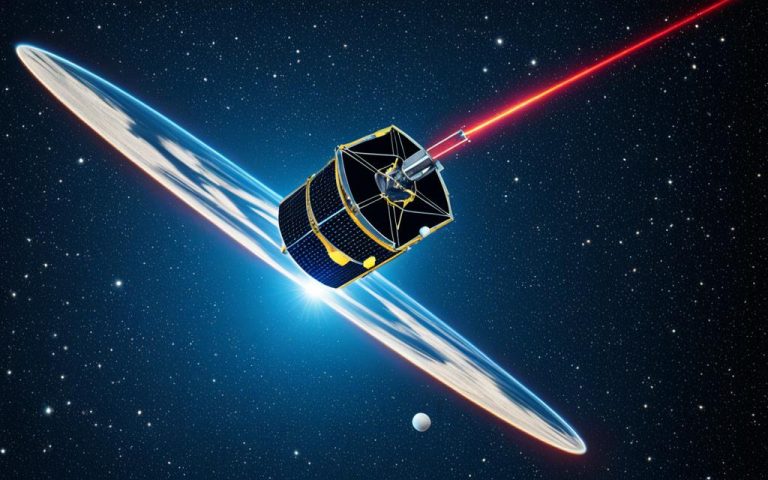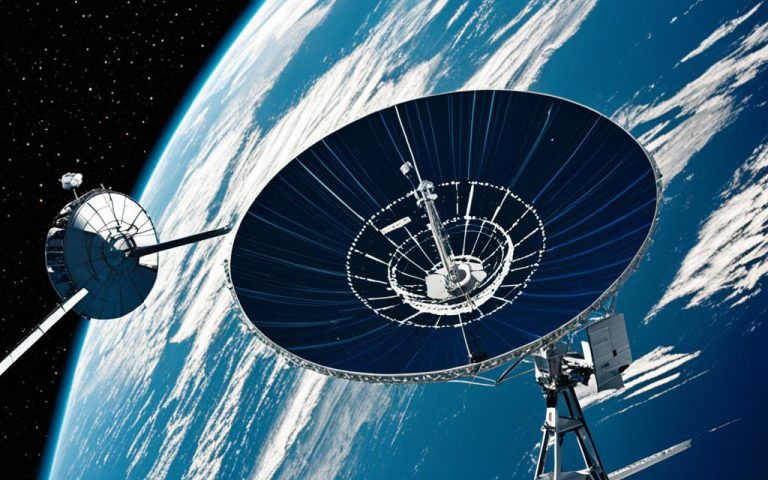Machine-to-machine (M2M) communication is a vital aspect of connecting devices without human intervention in satellite networks. These networks rely on robust protocols to ensure seamless and efficient M2M communication. In this article, we will explore the significance of protocols in enabling M2M communication in satellite networks and provide best practices to optimize this process.
When it comes to M2M communication, protocols such as TCP/IP, UDP, ICMP, HTTP, and MQTT play a crucial role. These protocols facilitate data exchange between devices and ensure reliable and secure transmission. By choosing the right protocol, the efficiency and reliability of M2M communication can be enhanced.
Optimizing the network configuration is crucial for efficient M2M communication in satellite networks. This process involves assigning unique and valid IP addresses, setting appropriate subnet masks, ensuring functional gateways, and utilizing reliable DNS servers. By configuring the network settings effectively, the performance of M2M communication can be significantly improved.
Security is a top priority in M2M communication. Encryption, authentication, and authorization mechanisms are essential to protect data and devices from unauthorized access. Protocols like SSL, TLS, and IPSec provide the necessary security measures for secure M2M communication. Implementing these mechanisms effectively ensures the confidentiality and integrity of data.
Proactive monitoring and troubleshooting are vital to maintain the proper functioning and efficiency of M2M communication in satellite networks. By regularly monitoring performance, availability, and quality and identifying and resolving issues, errors and bottlenecks can be detected and resolved in a timely manner.
In conclusion, the proper selection of protocols, optimization of network configuration, and implementation of security measures are crucial for seamless and efficient M2M communication in satellite networks. By following best practices and staying updated with the latest trends, organizations can achieve optimal performance and reliability in their M2M communication endeavors.
Choosing the Right Protocol
When it comes to M2M communication in satellite networks, selecting the appropriate protocol is essential to ensure efficient and reliable data transfer. The TCP/IP suite consists of a range of protocols that serve different functions and features, providing flexibility for M2M communication.
TCP/IP Protocol Suite
The Transmission Control Protocol (TCP) is ideal for situations that require reliable and ordered data delivery. It establishes a connection between devices, ensuring that data packets are received in the correct order. TCP also provides error-checking and retransmission mechanisms, enhancing the overall integrity of the communication process.
On the other hand, the User Datagram Protocol (UDP) is more suitable for low-latency and real-time communication scenarios. UDP operates on a connectionless basis and does not guarantee reliable delivery or packet ordering. However, its lightweight nature allows for faster data transmission, making it an excellent choice for applications that prioritize speed over reliability.
Other Protocols for M2M Communication
In addition to TCP/IP, other protocols like ICMP, HTTP, and MQTT play significant roles in facilitating M2M communication in satellite networks.
ICMP (Internet Control Message Protocol) enables the exchange of control and error messages between devices. It plays a crucial role in network diagnostics and troubleshooting, allowing devices to communicate important network information and detect issues.
HTTP (Hypertext Transfer Protocol) is widely used for web communication. It enables devices to request and retrieve web pages or resources, making it suitable for M2M applications that involve web-based data exchange or remote device management.
MQTT (Message Queuing Telemetry Transport) is a lightweight publish-subscribe messaging protocol that is designed for resource-constrained devices. It offers efficient and reliable data transfer, making it ideal for M2M applications that require scalable communication across a large number of devices.
By carefully selecting the appropriate protocol based on specific requirements, M2M communication in satellite networks can be optimized in terms of efficiency, reliability, and performance.
Optimizing Network Configuration
To optimize machine-to-machine (M2M) communication in satellite networks, proper network configuration plays a crucial role. By ensuring the right settings, such as assigning unique IP addresses, setting subnet masks and gateways, and utilizing reliable DNS servers, the performance and functionality of M2M communication can be significantly improved.
IP Address Configuration
Assigning unique and valid IP addresses to devices is essential for establishing communication within a satellite network. Each device must have a distinct IP address to identify and differentiate it from other devices. By using IP addresses, data packets can be sent and received accurately, enabling efficient M2M communication.
Subnet Mask and Gateway
The subnet mask determines the network’s range within the satellite network and enables devices to communicate with each other. It ensures that data packets are sent to the correct destination. On the other hand, the gateway acts as an intermediary between devices within the satellite network and devices in external networks. It facilitates data flow between different networks, enabling M2M communication across networks.
DNS Server
A reliable and secure Domain Name System (DNS) server is crucial for resolving domain names into IP addresses. By utilizing a functional DNS server, devices in the satellite network can easily access websites, services, and resources by their domain names. DNS servers ensure efficient and accurate communication between devices by translating human-readable domain names into IP addresses.
Dynamic Host Configuration Protocol (DHCP)
When configuring the network, you have the option to choose between static IP addresses and dynamic host configuration protocol (DHCP). Static IP addresses are manually assigned to each device, ensuring a fixed address for consistent communication. On the other hand, DHCP automatically assigns IP addresses to devices within the network, simplifying the network configuration process. DHCP dynamically manages IP addresses, preventing conflicts and optimizing address allocation within the M2M satellite network.
By configuring these network settings effectively, M2M communication within satellite networks can be optimized, leading to improved performance, reliability, and overall functionality.

| Network Configuration Steps | Benefits |
|---|---|
| Assign unique IP addresses | Ensures accurate device identification |
| Set appropriate subnet masks | Facilitates communication within the satellite network |
| Ensure functional gateways | Enables communication between different networks |
| Utilize reliable DNS servers | Facilitates domain name resolution and smooth communication |
| Choose between static IP addresses and DHCP | Simplifies network configuration and prevents IP conflicts |
Ensuring Secure Communication
Security is an integral aspect of machine-to-machine (M2M) communication in satellite networks. To protect data and devices from unauthorized access or manipulation, encryption, authentication, and authorization mechanisms are essential. By implementing protocols such as SSL, TLS, and IPSec, M2M communication can be safeguarded, ensuring the confidentiality and integrity of data transmission.
Encryption plays a critical role in secure communication by encoding data to make it unreadable to unauthorized parties. It ensures that even if intercepted, the information remains inaccessible. Authentication verifies the identities of communicating devices, preventing unauthorized devices from gaining access. Authorization, on the other hand, controls device permissions and access rights, allowing only authorized devices to interact with each other.
“Encryption, authentication, and authorization mechanisms are crucial in securing M2M communication.”
Implementing protocols like SSL, TLS, and IPSec provides the necessary security measures for M2M communication in satellite networks. These protocols establish secure connections, authenticate communicating entities, and ensure data integrity through encryption. By leveraging these protocols effectively, organizations can mitigate the risks associated with unauthorized access and protect sensitive information from interception or tampering.
SSL, or Secure Sockets Layer, is a widely used protocol that ensures secure communication over the internet. It employs encryption to protect data during transmission, providing a secure channel between devices. TLS, or Transport Layer Security, is an updated and more secure version of SSL, offering enhanced encryption algorithms and stronger security features.
IPSec, or Internet Protocol Security, is a protocol suite used to establish secure communication at the network layer. It provides encryption, authentication, and authorization services for IP packets, ensuring secure transmission between devices. IPSec can be implemented in various modes, such as transport mode and tunnel mode, depending on the specific security requirements.
“Protocols like SSL, TLS, and IPSec play a crucial role in securing M2M communication in satellite networks.”
By utilizing these encryption, authentication, and authorization mechanisms effectively, organizations can establish a secure framework for M2M communication in satellite networks. This ensures that sensitive data remains protected, preventing unauthorized access and maintaining the integrity of communication channels.
| Protocol | Features |
|---|---|
| SSL | – Ensures secure communication – Encrypts data transmission – Provides authentication of communicating entities |
| TLS | – Offers enhanced security compared to SSL – Implements more advanced encryption algorithms – Protects data integrity during transmission |
| IPSec | – Establishes secure communication at the network layer – Provides encryption, authentication, and authorization for IP packets – Offers different modes for varying security requirements |
Monitoring and Troubleshooting Communication
Regular monitoring and troubleshooting are essential to ensure the proper functioning and efficiency of M2M communication in satellite networks. By proactively monitoring and troubleshooting communication, errors and bottlenecks can be detected and resolved, leading to optimized M2M communication.
Monitoring Communication
Monitoring involves analyzing data related to performance, availability, and quality using various tools and technologies.
“Monitoring is the key to a healthy and robust M2M communication network. It provides valuable insights into the network’s performance and allows for proactive identification and resolution of issues.”
Network analyzers, packet sniffers, and command-line tools are commonly used to monitor M2M communication. Network analyzers capture and analyze network traffic, providing detailed information about packet transfers, latency, and errors. Packet sniffers intercept and analyze network packets, allowing for the examination of packet contents and identification of issues.
Command-line tools, such as ping and traceroute, help assess network connectivity and diagnose network-related problems. These tools provide valuable information about response times and the path taken by packets, facilitating troubleshooting activities.
Troubleshooting Communication
Troubleshooting involves identifying and resolving issues or problems that affect M2M communication.
“Troubleshooting is a proactive approach toward maintaining an efficient and reliable M2M communication network. It helps identify and resolve issues before they impact critical operations.”
Debuggers, loggers, and error messages are the primary tools used for troubleshooting M2M communication. Debuggers help identify problems in software codes, allowing developers to pinpoint and fix errors effectively. Loggers record system activities, enabling the analysis of events leading up to an issue. Error messages provide valuable information to diagnose and resolve specific errors or failures in M2M communication.
Comparison of Network Monitoring Tools
| Tool | Functionality | Benefits |
|---|---|---|
| Network Analyzer | Captures and analyzes network traffic |
|
| Packet Sniffer | Intercepts and analyzes network packets |
|
| Command-line Tools | Assess network connectivity and diagnose problems |
|
Conclusion
In conclusion, the use of satellite M2M protocols is crucial in ensuring robust and efficient communication in satellite networks. By implementing the right protocols, optimizing network configuration, ensuring secure communication, and proactively monitoring and troubleshooting, organizations can enhance the performance and reliability of their M2M communication.
Choosing the appropriate protocols, such as TCP/IP, UDP, ICMP, HTTP, and MQTT, based on specific requirements is essential for reliable data delivery, low latency, and real-time communication. Optimal network configuration, including proper IP address assignment, subnet masks, gateways, and DNS servers, improves overall functionality.
Implementing security measures, such as encryption, authentication, and authorization through protocols like SSL, TLS, and IPSec, helps protect data and devices from unauthorized access. Regular monitoring using network analyzers, packet sniffers, and proper troubleshooting using debuggers, loggers, and error messages allows for the identification and resolution of potential issues.
To stay ahead and maximize the benefits offered by M2M communication in satellite networks, organizations should also keep up with best practices and trends in communication systems. This helps them adapt to changing conditions and take advantage of emerging technologies. By following these best practices, organizations can achieve seamless and effective M2M communication in their satellite networks.
FAQ
What is M2M communication?
Machine-to-machine (M2M) communication is the exchange of data between devices without human intervention, using networks such as the internet.
How do protocols enable M2M communication in satellite networks?
Protocols such as TCP/IP, UDP, ICMP, HTTP, and MQTT facilitate robust M2M communication in satellite networks by providing reliable data delivery, low latency, and real-time communication.
Which protocol should be chosen for M2M communication in satellite networks?
The choice of protocol depends on specific requirements. TCP is suitable for reliable and ordered data delivery, while UDP is more appropriate for low latency and real-time communication. ICMP, HTTP, and MQTT have their own strengths and applications in facilitating M2M communication.
What is the importance of network configuration in optimizing M2M communication?
Proper network configuration, including assigning unique and valid IP addresses, setting subnet masks and gateways, and utilizing reliable DNS servers, improves the performance and functionality of M2M communication. The decision between static IP addresses and dynamic host configuration protocol (DHCP) also plays a role in automatic IP address assignment.
How can security be ensured in M2M communication in satellite networks?
Encryption, authentication, and authorization mechanisms such as SSL, TLS, and IPSec are essential for securing M2M communication in satellite networks. These mechanisms protect data and devices from unauthorized access or manipulation.
Why is monitoring and troubleshooting important in M2M communication?
Regular monitoring and troubleshooting help ensure the proper functioning and efficiency of M2M communication in satellite networks. Tools like network analyzers, packet sniffers, debuggers, and error messages are used to analyze data, identify and resolve issues, and detect errors and bottlenecks.
How can the performance and reliability of M2M communication be enhanced in satellite networks?
By choosing the right protocols, optimizing network configuration, ensuring secure communication, and proactively monitoring and troubleshooting, the performance and reliability of M2M communication can be enhanced.



















